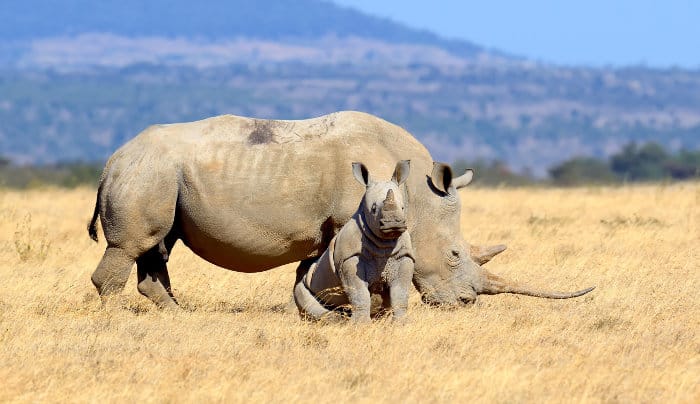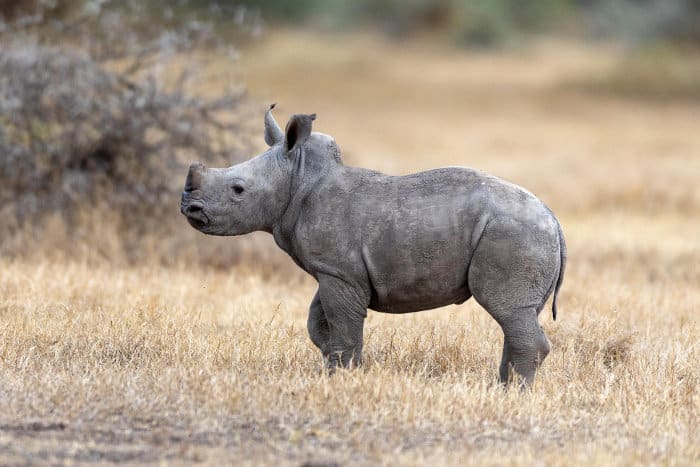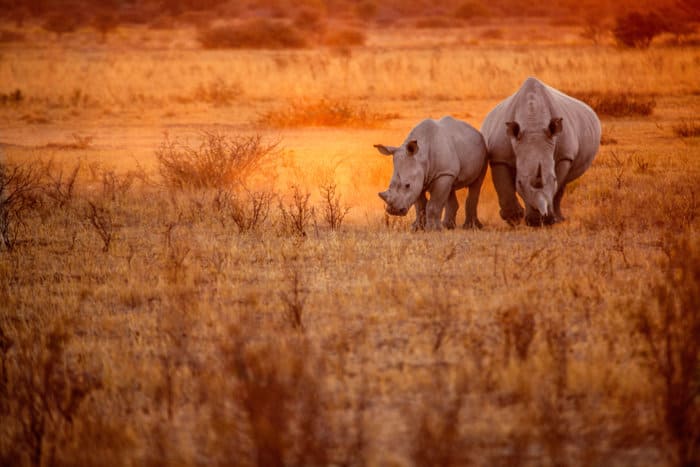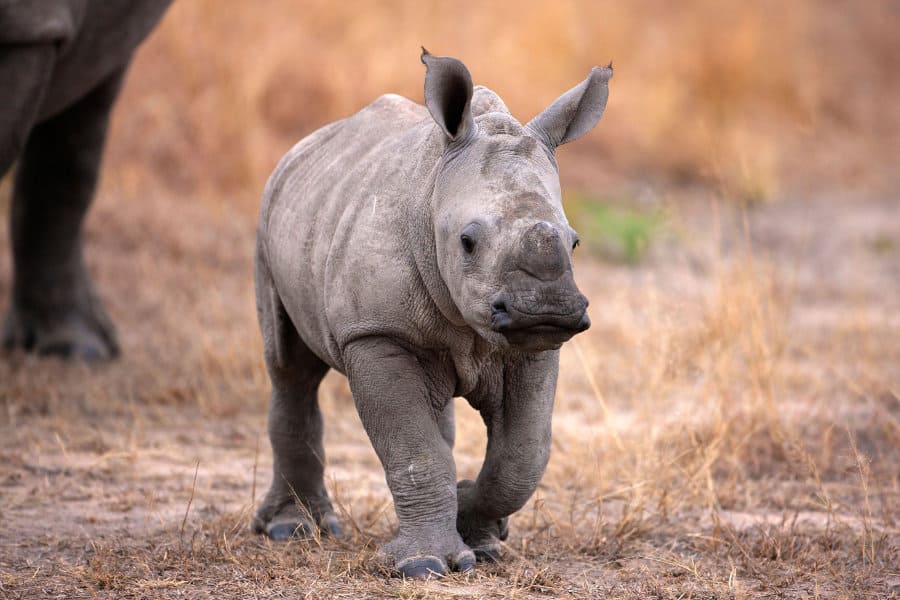A baby rhino is surely one of Africa’s most adorable inhabitants. Seeing one practicing its charge will put a smile on anyone’s face – unless its mother is following suit and heading in your direction!
Of the five living species of rhino, two call Africa home – the white rhinoceros and the black rhinoceros. They have their differences, but one similarity is their unreasonably cute offspring. Whether you’re on a South African safari or exploring the Ngorongoro Crater, catching a glimpse of either species is always a privilege.
If a baby rhino survives its early years, it will grow into one of Africa’s largest and toughest animals, with a pair of magnificent horns. But there are still challenges ahead, and its distinguishing feature puts it at risk from poachers.
Want to know what to call a baby rhino, what it eats, or when it grows its iconic horn? Get your fix of baby rhino facts below.
What is a Baby Rhino Called?

What is a baby rhino called? The same thing as a baby elephant. In other words: a calf.
The comparison doesn’t end there. A male rhino calf will grow up to be a bull, and a female will grow up to be a cow. That’s also the same as hippos, giraffes, and buffalo, so it shouldn’t be too hard to remember.
Seeing a small rhino calf peek out from behind its mother, it’s hard to believe it will grow into one of the world’s largest land animals. Elephants are the only animals that pip white rhinos size-wise, but the crown for ‘cutest calf’ is still up for debate.
What does a baby rhino weigh?
‘Small’ is relative – baby rhinos are quite large at birth compared to most animals!
Mothers of both species give birth to a single calf, after a 15-month (black rhinos) or 16-month (white rhinos) gestation period. A black rhino calf weighs around 35-50 kg, while the larger white rhino gives birth to a 40-65 kg baby.
Calves pack on size quickly, growing two or three kilograms per day in their early life. By the time they’re fully grown, most African rhinos will exceed a tonne. Male white rhinos average over two tonnes, and sometimes over three!
How do they get so big? Well, this huge herbivore has an appetite to match.
What do baby rhinos eat? Low-fat milk and poop

Like any mammal, a baby rhino needs its mother’s milk to grow big and strong. Rhino milk is quite unusual in that it’s extremely low in fat.
This could be because of the mother’s long lactation period – calves may continue to suckle for a year or more. Therefore, producing calorie and nutrient-dense milk would be too much of a strain.
Before calves are fully weaned, they must prepare their bodies for their adult diet. Specifically, their digestive systems, which lack the bacteria to digest vegetation at birth. How do they get these bacteria? By eating their mother’s dung!
This switch in a baby rhino’s diet doesn’t happen overnight. They must munch on dung for a few months to properly prepare their gut for a lifetime of grazing or browsing.
Browsers vs grazers
What a baby rhino eats, apart from milk (and poop!) depends on its species. Black and white rhinos, despite their similarities, have evolved to occupy very different niches.
White rhinos mainly live on the open grasslands, or savannas, of southern Africa. As grazers, they eat grass and other low-lying vegetation.
Another name for this species is the square-lipped rhinoceros, and you can see why. It holds its large head close to the ground and hoovers up grass.
Black rhinos live in several southern and eastern African countries, and they spend more time in mixed grasslands and woodlands. As browsers, they favour plants, shoots, branches, and even thorny bushes like the Acacia tree.
Appearance-wise, the black rhino has its own adaptations that set it apart from its relative. Its distinctive, hooked lip helps it grasp and pull leaves and stalks from trees. It holds its head higher, allowing it to reach its favourite foods.
Depending on species, the baby rhino’s mother will teach it how to feed on its preferred type of vegetation. Before long, it will have moved on from its low-fat smoothies and embraced a 100% plant-based diet.
Baby Rhino Life Cycle

Baby rhinos are a lot like us in many respects. They’re not quite as helpless, though – rhino calves are unsteady on their feet for their first few days, but after that, they can follow their mothers around.
The young calf relies heavily on its mother for food and protection in its early months and years, while males play no part in the rearing of young. Baby rhinos will stay with their mother for two or three years, during which time she won’t mate with other males.
The early months and years are a critically important time for rhino calves to learn life skills. There’s also time for playing – playful baby rhinos love practicing their charge – but even this will be important when they grow up and defend their own territory.
Leaving home
Male rhino calves leave their mother earlier than females and set out on their own. The mother will mate with another suitor and rear another baby, while the sub-adult calf has to find its own territory.
It can be another tough time for the young rhino. Rhinos with established territories may chase them off or try to fight.
Male rhinos generally live more solitary lives, only seeking out females for mating and otherwise living alone. Female black rhinos are also mainly solitary, but female white rhinos will often live in small herds, or ‘crashes’, with other females or young males.
Baby rhino threats
No predators tangle with an adult rhino, short of a moody bull elephant in musth. Even baby rhinos are no easy target – mostly because predators have to get through an angry mother first.
There are still several species that will occasionally eat baby rhinos. Lions are a rhino calf’s most common predator in Africa, while hyenas, leopards, African hunting dogs, and even Nile crocodiles occasionally prey on them. Asian species are most vulnerable to tigers.
Baby rhinos’ biggest (non-human) threats have got to be other rhinos. Adult males sometimes attack or even kill baby rhinos that prevent them from mating. And when the calves leave their mothers, they may have to fight to claim new territory.
Even as an adult, rhinos aren’t safe from their own kin. Black rhinos, especially, have a famously grumpy temperament. Fights are common, and often fatal for the loser.
Do Baby Rhinos Have Horns?

If you see a photo of a baby rhino, you should have your answer. Rhino calves are born without horns, which their mothers are probably thankful for!
Look closer, and you can make out the stub from which the horn will grow. It doesn’t take long – within a couple of months it will start to appear, though it will be a long time before it looks anywhere near fully grown.
Rhino horns are not really ‘horns’ at all. They’re made of keratin, the same substance as our fingernails. Once the baby rhino’s horns begin to grow, they will keep growing throughout its life. This happens very slowly, at several centimetres per year.
With a rhino’s long lifespan, it means older individuals can have very long horns indeed. The record for a white rhino is 150 cm!
Life doesn’t get easier
This horn is a blessing and a curse to a baby rhino as it grows up. It’s great for self-defence, but it also brings unwanted attention from two-legged foes.
Keratin has no known medical benefits, yet rhino horn is still coveted in some areas for its supposed medicinal properties. Most of the demand is overseas, in Asian countries like China and Vietnam.
South Africa has both the most rhinos and the most poaching, with over 1000 rhinos being killed each year between 2013-2017. Numbers have dropped in recent years, but around one rhino per day is still killed for its horn.
Whether it’s initiatives like dehorning rhinos to deter poachers, or educating communities on the benefits of conservation, rhino calves need more help if they’re to have a brighter future.
See a Baby Rhino in Action

Now you know these baby rhino facts, there’s no substitute for seeing one yourself.
Black rhinos are now critically endangered. White rhinos are also at risk, with one subspecies, the northern white rhino, recently going extinct in the wild.
These magnificent creatures are an important part of African ecosystems and losing them would be a big blow. Without more action to crack down on poaching and debunk medicinal myths, a beautiful baby rhino bounding across the savanna will be an ever-rarer sight.
Ecotourism efforts are one way of showing that rhinos are more valuable alive than dead. Safaris in Kruger National Park in South Africa, Etosha National Park in Namibia, or Tanzania’s Ngorongoro Crater, give you a chance of seeing these awesome animals.



